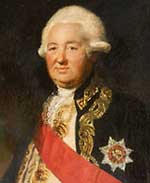Sir Edward Hughes

Engelsk admiral.
- Madras III, 1782
- Trincomalee I, 1782
- Cuddalore I, 1782
- Trincomalee II, 1782
- Cuddalore II, 1783
British admiral, entered the Royal Navy in 1735, and four years later was present at Porto Bello. In 1740 he became lieutenant, and i1~ that rank served in the Cartagena expedition of 1741, and at the indecisive battle of Toulon. In H.M.S. Warwick he was presertt at the action with the Glorioso, but in default of proper support from the Lark (which was sailing in company with the Warwick), the combat ended with the enemys escape. The commander of the Lark was subsequently tried and condemned for his conduct, and Hughes received the vacant command. Captain Hughes was with Boscawen at Louisburg and with Saunders at Quebec. He was in continual employment during the peace, and as Commodore commanded in the East Indies from 1773 to 777. It was not long before he returned to the East as a rear-admiral, with an overwhelming naval force. On his outward voyage he ietook Goree from the French, and he was called upon to conduct only minor operations for the next two years, as the enemy could not muster any force fit to meet the powerful squadron Hughes had brought from the Channel. In 1782 he stormed Trincomalee a few days before the squadron of Suifren arrived in the neighbourhood. For the next year these Indian waters were the scene of one of the most famous of naval campaigns. Suffren (q.v.) was perhaps the ablest sea-commander that France ever produced, btit his subordinates were factious and unskilful; Hughes on the other hand, whose ability was that born of long experience rather than genius, was well supported. No fewer than five fiercely contested general actions were fought by two fleets, neither of them gaining a decisive advantage. In the end Hughes held his ground. After the peace he returned to England, and, though further promotions came to him, he never again hoisted his flag. He had accumulated considerable wealth during his Indian service, which for the most part he spent in unostentatious charity. He died at his seat of Luxborough in Essex in 1794.